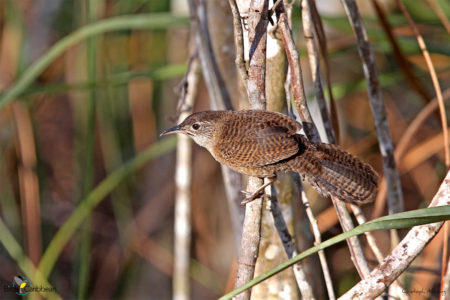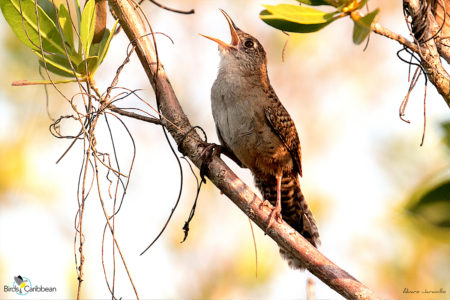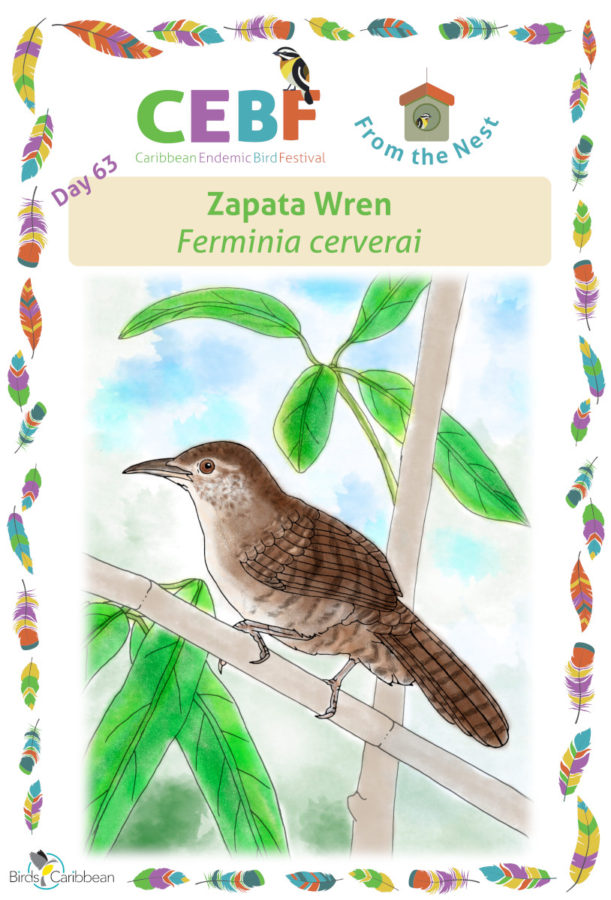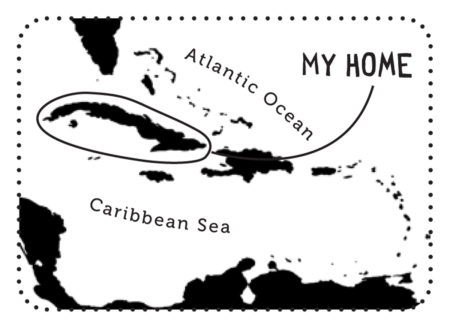Celebrate the Caribbean Endemic Bird Festival (CEBF) with us! Our theme in 2021 is “Sing, Fly, Soar—Like a Bird!” Have fun learning about a new endemic bird every day. We have colouring pages, puzzles, activities, and more. Download for free and enjoy nature with your family at home.
Endemic Bird of the Day: Zapata Wren
The spectacularly beautiful song of the Zapata Wren welcomes many visitors to the Zapata Swamp National Park. When you hear it, there is no doubt that you have reached the only place in the world where this melodious species lives. The Zapata Wren is one of three endemics named for this important Caribbean wetland in the late 1920s by Spanish soldier and naturalist, Fermín Cervera, who is commemorated in the scientific name of the species (Ferminia cerverai).
There are several distinctive features of these beautiful birds. Their upperparts are rich brown with heavy dark barring (stripes) on the back and tail. The underparts are whitish to light gray-brown with barring on the flanks and undertail feathers. The long tail is often held straight up when the bird is perched, however, the tail is down when the bird is singing. The bill is long and slightly down-curved, dark brown above and paler yellow-brown below. The sexes look alike. Juveniles are similar to adults, but with fine blackish speckles on the throat and less distinct barring on the flanks.
To see the Zapata Wren, you have to visit its characteristic habitat, very early in the morning, on non-windy days, and listen for its song. It is challenging to observe due to its cryptic coloration, highly secretive nature, and because it quickly disappears into the vegetation in the face of any alarm. Although their precise range is not known, they are restricted to savanna-type swamp in western Zapata Swamp where sawgrass (Cladium jamaicense) and cattail (Typha domingensis), with scattered bushes, predominate.
The Zapata Wren forages in low vegetation and on the ground. It eats insects, caterpillars, spiders, mollusks, small fruits, and even lizards. Its typical song is high, strong and very musical, “Tseuu-we-we-we-tu-tu-tu-tu-tu-tu-tu-tu-tu,” usually repeated 3 times. Nesting takes place between January and July. Pairs build a ball-shaped nest of sawgrass leaves lined with feathers, with a side entrance. Nests are low to the ground, in sawgrass. They are similar to nests of other seed-eating birds, and almost impossible to find. They lay 2 eggs white, on alternate days. Only the female incubates; both parents feed the young. The first nest was discovered in 1986 and only 5 have been found so far!
The Zapata Wren is the only member of its family that lives in the Greater Antilles year-round (2 other species are considered accidental). It is Endangered, due to its small population (recent estimates suggest between 120 and 140 pairs) and very small range. The main threats to its survival are periodic fires and possible predation by introduced mongoose, rats, and catfish (Claria sp). Conservation of this species is a high priority in the National Park Management Plans. Learn more about this species, including its range, photos, and calls here.
Colour in the Zapata Wren
Download our West Indies Endemic Bird colouring page. Use the photos below as your guide, or you can look up pictures of the bird online or in a bird field guide if you have one. Share your coloured-in page with us by posting it online and tagging us @BirdsCaribbean #CEBFfromthenest
Listen to the song of the Zapata Wren
The Zapata Wren is most often found by listening out for it’s “Tseuu-we-we-we-tu-tu-tu-tu-tu-tu-tu-tu-tu” song, usually repeated 3 times. It also has sharp, buzzy chips and harsh notes of various tones.
Puzzle of the Day
Click on the image below to do the puzzle. You can make the puzzle as easy or as hard as you like – for example, 6, 8, or 12 pieces for young children, all the way up to 1,024 pieces for those that are up for a challenge!


Activity of the Day
FOR KIDS: Say hello to someone in your family or a special friend AND celebrate endemic birds with a fun Greeting Card for you to download and colour! With a cute bird-themed picture for you to customise, our card also features a beautiful drawing of today’s endemic bird – the Zapata Wren- along with some wren facts!
Please download and print our card template (letter size will work best but A4 will be ok too). It’s best to use card stock, but regular printer paper will do just fine. Once printed, fold in half horizontally (so the short sides touch) and write your own special message on the inside! Don’t forget to colour in the pictures on the front and on the back. Or if you are feeling really creative be inspired by one our featured birds and draw your own greeting card!
FOR KIDS AND ADULTS: Did you know that the melodious song of the Zapata Wren has inspired musicians? Last year Shika Shika released their album “A Guide to the Birdsong of Mexico, Central America, & the Caribbean”. The project was a unique fusion of music and birdsong , the ten-track electronic music album, incorporated the songs and calls of endangered birds. Amongst the calls and songs of endemic from the region, there was a track incorporating the sweet song the the Zapata Wren! You can still listen to the tracks on Shika-Shika’s Bandcamp website. Read all about how Shika Shika managed to raise an amazing $30, 000 USD for bird conservation in to our blog post:
And finally, here is a video of a Zapata Wren singing it’s heart out in Zapata Swamp, Cuba (video by Lisa Sorenson).



